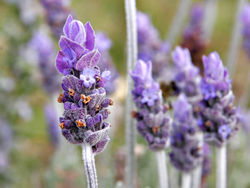It:Linalool
Introduction
Lavender is a shrubby plant in the mint family with about 25-30 species. It is native from the Mediterranean region south to tropical Afric and the east to India. The aromatic smell is found in all parts of the shrub, but the essential oil is only produced from the flowers and flower-stalks. The lavender flower oil is a complex mixture compounds containing linalool, linalyl acetate, 1, 8-cineole, β-ocimene and so on.
A picture of Lavender flower.
Linalool
Linaloolis a colourless fragrant liquid which can be found in many essential oil. As a fragrance, it is used in many soaps, detergents, creams, lotions, shampoos and it is a chemical intermediate in the formation of Vitamin E. It is also an insecticide which is safe to humans.
 2D-strcture of a Linalool Molecule
2D-strcture of a Linalool Molecule
3D -Structure of A Linalool Molecule
| Einecs Number | 201-134-4 | |
|---|---|---|
| CAS Number | 78-70-6 | |
| Chemical Name | Linalool | |
| Autoname | 3,7-Dimethyl-1,6-octadien-3-ol | |
| Molecular Formula | C10H18O | |
| Molecular Weight | 154.25 g/mol | |
| Physical State | Clear to slightly yellow liquid | |
| Boiling Point | 198-200C | |
| Solubility in Water | Insoluble | |
| Flash Point | 75C | |
| Toxicity | Oral rat LD50: 2790 mg/kg |
|
Synthesis of linalool
Linalool is an anyclic alcohol. It has a sweet, pleasant fragrance and is one of the most frequently encountered floral scent compounds. Linalool has two enantiomeric forms (R) - linalool and (S) - linalool corresponds to the chiral properties of its hydroxylated third carbon. Traditionally, linalool was obtained from α- or β-pinene. The most modern synthesis start with 2-methyl-2-hepten-6-one and proceed via base-calalyzed ethynylation with acetylene to dehydrolinalool, yielding linalool through hydrogenation of the triple bond in the presence of a palladium-carbon catalyst.
The process of sysnthesising a linalool molecule.
Uses of Lavender oil
Generally its modern use is for aromatherapy. The research in lab showed that it helped in the reduction of advanced mammory tumors in lab rats. Some other researches such as potential breast, ovarian, pancreatic, liver, and prostate cancer treatments are on-going. Some advocates of alternative medicine claim that lavender oil can be used in a variety of variety.
• Cream: Add a few drops of oil to chamomile cream for eczema. • Lotion: Add a few drops of oil to a little water for sunburn or scalds. • Chest Rub: Add 1 ml oil and 5 drops chamomile oil to 10 ml carrier oil for asthmatic and bronchitic spasm. • Hair Rinse: Dilute 5-10 drops of oil in water for lice, or use a few drops of neat oil on a fine comb for nits. • Oil Apply undiluted to insect bites and stings: Dilute 10 drops oil in 25 ml carrier oil for sunstroke or to help prevent sunburn. • Massage Oil: Dilute 1 ml 'lavender oil' in 25 ml carrier oil, and massage into painful muscles.Dilute 10 drops in 25 ml carrier oil and massage into the temples and nape of the neck for tension headaches or at the first hint of a migraine.
Side Effects of Lavender oil
A July 1, 2006 article in Science News stated that lavender oil had been implicated in abnormal development of the breasts in young boys. Boys and girls are particularly sensitive to estrogenic and androgenic compounds because their sex hormone levels are low prior to puberty.There are identified hormonally active compounds in lavender oil which may be contributing to the increase incidence of early breast development in girls and enlarged breasts in boys.
References
1. http://en.wikipedia.org/wiki/Lavender
2. http://www.umich.edu/~chemh215/CHEM216/HonorsCup/hcproposal/251__A.pdf
3. http://www.linguasphere.org/dictionary/n-42188-linalool.html
4. http://www.chemicalland21.com/specialtychem/perchem/LINALOOL.htm
5. http://www.molecular-networks.com/online_demos/corina_demo.html


